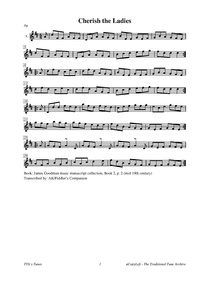Template:Pagina principale/Vetrina: Difference between revisions
No edit summary |
No edit summary |
||
| Line 1: | Line 1: | ||
{{SheetMusic | {{SheetMusic | ||
|f_track= | |f_track=Cherish the Ladies.mp3 | ||
|f_pdf= | |f_pdf=Cherish the Ladies.pdf | ||
|f_artwork= | |f_artwork=Michael-Coleman.jpg | ||
|f_tune_name= | |f_tune_name=Cherish_the_Ladies | ||
|f_track_title= | |f_track_title=Cherish the Ladies | ||
|f_section=abc | |f_section=abc | ||
|f_played_by=[https://soundcloud.com/trad-tune-collection Fionnlagh Ballantine] | |f_played_by=[https://soundcloud.com/trad-tune-collection Fionnlagh Ballantine] | ||
|f_notes= | |f_notes= Michael Coleman (31 January 1891 – 4 January 1945) was a virtuoso Irish fiddler from County Sligo, and a major exponent of the Sligo fiddle style. | ||
|f_caption= | |f_caption=The Petrie setting referred to is Stanford/Petrie 921; it is in three parts, with the second part practically identical to Howe's third. Joyce's two-part setting (J4:25) consists of the first part common to all the other settings cited, plus the part which is second in Petrie, third in Howe and Ryan, and fourth in the Gillan/O'Neill setting. | ||
|f_source=[https://soundcloud.com/ | |f_source=[https://soundcloud.com/paddyglackin/cherish-the-ladies Soundcloud] | ||
|f_pix=420 | |f_pix=420 | ||
|f_picpix=200 | |f_picpix=200 | ||
|f_article=[[ | |f_article=[[Cherish_the_Ladies | '''Cherish the Ladies''']] | ||
is a popular session jig. O'Neill ('''Irish Folk Music''', p. 94) says: "Dr. Petrie refers to it as a Munster jig, yet none whom the writer heard play it in any style were natives of that province. In its original form of two strains it was one of Jackson's jigs, and Dr. Petrie's opinion receives corroboration by finding a simple version of the tune in Dr. Joyce's '''Old Irish Folk Airs and Songs''', just published." O'Neill remarks again in '''Irish Minstrels and Musicians''' (1913, p. 183) the tune had been ascribed to the famous 18th century County Limerick composer Walker 'Piper' Jackson. He did not specify where he obtained this information, but "Jackson" is listed as the composer in Elias Howe's c. 1866 '''Musician's Omnibus No. 3''' (p. 220). Paul de Grae (notes to MOI/DMI, 2017) is of the opinion that Howe's version of "Cherish the Ladies" formed the basis for Chief O'Neill's more elaborate six-part one, as the first two stains are "almost exactly identical, and the Howe/Ryan's third part is very like O'Neill's (or rather, Gillan's) fourth part." O'Neill also printed the first two strains of his "Cherish the Ladies" independent of his other strains under the title "[[Humors of Cappa (2) (The)]]." | |||
}} | }} | ||
Revision as of 15:27, 24 March 2023

Played by: Fionnlagh Ballantine
Source: Soundcloud
Image: Michael Coleman (31 January 1891 – 4 January 1945) was a virtuoso Irish fiddler from County Sligo, and a major exponent of the Sligo fiddle style.

is a popular session jig. O'Neill (Irish Folk Music, p. 94) says: "Dr. Petrie refers to it as a Munster jig, yet none whom the writer heard play it in any style were natives of that province. In its original form of two strains it was one of Jackson's jigs, and Dr. Petrie's opinion receives corroboration by finding a simple version of the tune in Dr. Joyce's Old Irish Folk Airs and Songs, just published." O'Neill remarks again in Irish Minstrels and Musicians (1913, p. 183) the tune had been ascribed to the famous 18th century County Limerick composer Walker 'Piper' Jackson. He did not specify where he obtained this information, but "Jackson" is listed as the composer in Elias Howe's c. 1866 Musician's Omnibus No. 3 (p. 220). Paul de Grae (notes to MOI/DMI, 2017) is of the opinion that Howe's version of "Cherish the Ladies" formed the basis for Chief O'Neill's more elaborate six-part one, as the first two stains are "almost exactly identical, and the Howe/Ryan's third part is very like O'Neill's (or rather, Gillan's) fourth part." O'Neill also printed the first two strains of his "Cherish the Ladies" independent of his other strains under the title "Humors of Cappa (2) (The)."
...more at: Cherish_the_Ladies - full Score(s) and Annotations
X:1 T:Cherish the Ladies M:6/8 L:1/8 R:Jig B:James Goodman music manuscript collection, Book 2, p. 2 (mid-19th century) F:http://goodman.itma.ie/volume-two#?c=0&m=0&s=0&cv=5&z=368.0389%2C1220.6902%2C8396.3979%2C3216 F:at Trinity College Dublin / Irish Traditional Music Archive goodman.itma.ie Z:AK/Fiddler's Companion K:D V:1 clef=treble name="1." [V:1] A|dFF AFF|DFA AGF|BEE GEF|GBA GFE| dFF AFF|DFA AGF|Bcd efg|fdd d2:| |:A|dfd cec|dfd AGF|BEE GEF|GBA GFE| dfd cec|dfd AGF|Bcd efg|fdd d2:| |:A|Ddd fed|afd fed|cef gfg|ece gfe| agf bag|agf ede|fdB AGF|GEF GFE:| |:A|AGF ~A2D|AGF ~A2D|AGF ~A2D|GEF GFE| AFA BGB|cAc d2e|fdB AGF|GEF GFE:|]
